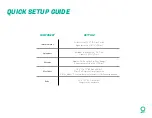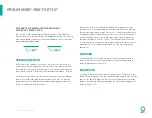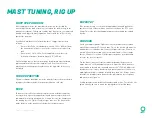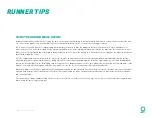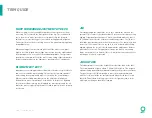
S TA R / T UNIN G GUIDE
JIB
Start by pulling in the jib until the leech lines up with the mark on the
spreader. This is where the jib should be 95 percent of time when sailing
upwind. If your boat does not have a mark, you should make one that is
18” (458mm) from the side of the mast on both spreaders. The jib sheet
should be played almost as much as the mainsheet. The best way to look
at the effects of control lines on the jib is to sit to leeward while sailing
upwind, sight up the leech of the jib, and make the adjustment. Witness
what it does to the sail. The upwind sail shape you want is a matching
shape on the main leech and the jib leech. A match means your sails are
working as efficiently as possible.
JIB HALYARD
The jib halyard determines the height of the jib off the deck of the boat.
The recommended height is about 1” (25mm) off the deck. This height is
a good starting point and should be adjusted to fit the needs of your boat.
The goal is to get the jib low enough to where, at maximum trim and
with the leech well inside the spreader mark when the jib sheet is two
blocked. This method of sailing is just to check if your halyard is in the
right spot, not how you should sail upwind.
MAST FORWARD ADJUSTMENT AT DECK
When reaching, use only enough forward lever to keep the mast from
reversing. The less bend, the more powerful the rig. The crew should
check the mast to make sure that it is straight. Set up the forward
adjustment so it just barely goes loose when sailing upwind in light air.
This keeps the mast from reversing on a reach without having to pull any
forward puller on.
When running, pull on the forward puller until the mast is straight or
slightly inverted. A good way to judge whether you have the right amount
of forward puller on is to look at the windward spreader. The spreader
should come straight out from the mast. It may swing slightly forward in
the puffs and swing aft in the light spots, but normally it’s straight out.
SLIDING MAST BUTT
Many boats use a sliding mast butt that allows the mast step to slide aft
and ease the shrouds when running. This keeps the leeward spreader
from cutting into the main and reduces tension on the leeward upper.
When using the sliding mast butt, move the aft pin back in light air.
Remember to move it forward one or two holes in the breeze. By doing
this, the mast butt is always touching both the mast partner and the aft
bolt at the mast step, keeping the mast locked in place when it’s forward
for the run.
TRIM GUIDE
Содержание STAR
Страница 1: ...STAR TUNING GUIDE ...



